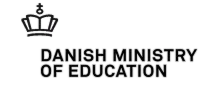Danish Ministry of Children and Education

About
Industry & location
The Danish Ministry of Children and Education operates in the public education sector, in Denmark. As the primary governmental body overseeing education, it serves as the central authority for educational policy and implementation across the country. The Ministry’s influence extends throughout Denmark, managing educational institutions from primary schools to universities.
Product & service
The Ministry provides comprehensive educational services and oversight for Denmark’s entire education system. They develop and implement educational policies, curricula, and digital learning solutions through their National Agency for IT and Learning. Their services include educational administration, policy development, and digital infrastructure management for learning institutions nationwide.
Mission
The Ministry’s mission is to deliver high-quality education that prepares students for a digital and globalized world. They strive to maintain Denmark’s progressive, inclusive, and innovative education system, ensuring equal opportunities for all learners. Their commitment extends to integrating modern digital tools and technologies to enhance teaching and learning experiences, fostering both academic excellence and future-ready skills.
The challenges
Infrastructure costs
Each technology transition, accompanied by new public tenders, led to millions in Danish Krone expenses for the Ministry. These frequent and often complex changes not only created an unsustainable financial burden but also strained resources, disrupted operations, and increased administrative overhead, making long-term planning and budget stability increasingly challenging.
Vendor lock-in
The Ministry’s dependence on proprietary solutions severely restricted their flexibility and ability to innovate. This significant limitation not only hindered their capacity to respond to evolving educational needs but also made it difficult to adapt quickly to new technologies, implement cost-effective alternatives, and meet the growing demands of a modern, dynamic education system.
Stakeholder demands
Meeting both internal and external stakeholder requirements while maintaining control over the cloud environment proved increasingly challenging. The existing infrastructure not only struggled to support rapid updates without causing major disruptions but also lacked the scalability, flexibility, and resilience needed to meet the demands of a modern, fast-paced digital ecosystem.
Technical complexity
Frequent changes in the underlying technology resulted in increased complexity and widespread inefficiencies across the system. This not only made system maintenance and updates increasingly difficult to manage but also placed a growing strain on resources, led to higher operational costs, prolonged downtimes, and significantly reduced overall system performance, reliability, and scalability.
The solutions
Scalable cloud infrastructure
The Ministry implemented OpenStack, Kubernetes, and Ceph as their primary infrastructure solution. This comprehensive open source approach provided full control over their cloud environment while eliminating vendor lock-in and reducing operational costs. The flexibility of these technologies enabled continuous integration and development.
Strategic partnership
The Ministry implemented OpenStack, Kubernetes, and Ceph as their primary infrastructure solution. This comprehensive open source approach provided full control over their cloud environment while eliminating vendor lock-in and reducing operational costs. The flexibility of these technologies enabled continuous integration and development.
Continuous integration
We established a system that support continuous integration and development, perfectly aligning with the Ministry’s agile approach. This solution enabled rapid deployment of new services and features, significantly enhanced collaboration, efficiency, and adaptability, and ensured seamless updates without disrupting existing operations or compromising overall system performance.
“The transition to OpenStack, Kubernetes and Ceph has transformed our IT infrastructure, allowing us to maintain full control while significantly improving agility and cost efficiency. With Fairbanks’ guidance, we’ve been able to continuously develop and deliver new services that truly benefit our students and educators.”
The results
Enhanced service delivery
Development teams can now deliver new services faster and with fewer manual interventions. The time-to-market for new services has been significantly shortened, allowing quicker responses to stakeholder needs.
Operational cost reduction
Development teams can now deliver new services faster and with fewer manual interventions. The time-to-market for new services has been significantly shortened, allowing quicker responses to stakeholder needs.
Technical autonomy
The Ministry gained full control over its cloud environment, enabling them to make changes and improvements without depending on external vendors. This autonomy has improved their ability to respond to specific educational needs.
Improved system stability
The new infrastructure brought enhanced stability and reliability, with simplified management, improved efficiency, and longer system lifecycles. This resulted in more consistent service delivery and significantly reduced system downtime.
Innovation leadership
The Ministry has positioned itself as a leader in digital transformation within the public sector. Their successful implementation of open source solutions has set a precedent for other government institutions.
Stakeholder satisfaction
The collaboration with Fairbanks and improved infrastructure have enhanced service delivery for staff, students, and educators. The platform’s continuous development ensures it meets user needs and supports growth.
